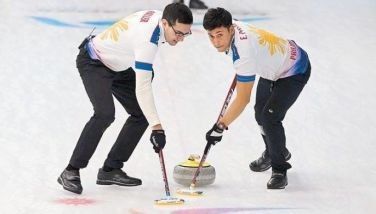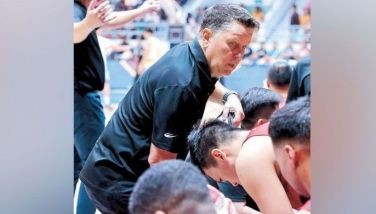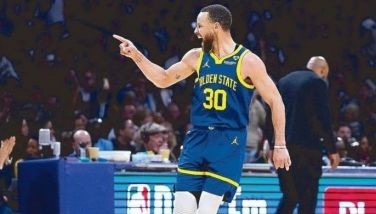Future of RP sports

October 29, 2000 | 12:00am
From the looks of things, POC president Celso Dayrit is on target in two of his four choices. There are promising signs in women’s weightlifting and marathon. But world standards in air rifle and archery may be too high for Filipinos to reach.
Other niche sports for consideration are judo, table tennis, taekwondo, badminton, and boxing.
Events with weight classes, particularly combat sports where the competition is mano-a-mano, are natural targets.
In women’s judo, athletes from Japan, South Korea, North Korea, and China took 12 of 28 medals in Sydney. Japan took three of seven gold medals in the men’s division. In table tennis, Asians nearly swept the 12 medals on the line, claiming 10. China bagged eight of the 10 medals. In taekwondo, Asian women took six of 12 medals and men, four of 12. In badminton, Asians collected 13 of 15 medals as Indonesia, China, and South Korea shared the bounty. In boxing, Thailand picked up a gold and a bronze while North Korea bagged a bronze. Kazakhstan had two golds and two silvers. Uzbekistan brought home a gold and two bronzes.
Failing to claim an Olympic medal wasn’t the Philippines’ exclusive right. The Philippines was in the company of Malaysia, Hong Kong, Uganda, Tunisia, Puerto Rico, Mongolia, Tonga, Syria, Ecuador, Burundi, Namibia, Myanmar, Bangladesh, Pakistan, Nepal, Brunei, and Singapore, among others.
The shutout hurt Malaysia more than the Philippines. At the 1996 Atlanta Games, Malaysia got a silver and a bronze in badminton. In Sydney, Malaysia sent 41 athletes who competed in 13 sports. Not even naturalized Malaysian citizen Irina Maharani, a shooter originally from the Ukraine, could make a difference.
Singapore hasn’t won an Olympic medal since a 1960 silver in swimming. There were 14 Singaporeans, including eight swimmers, in Sydney.
Vietnam and Sri Lanka upstaged the Philipines in the medal stakes. Tran Hieu Ngan captured Vietnam’s first-ever Olympic medal in women’s taekwondo and Sri Lanka’s Susanthika Jayasinghe claimed a bronze in the women’s 200-meter race.
Indonesia led Southeast Asian countries in the medal standings, bagging a gold, three silvers, and two bronzes. Thailand was next with a gold and two bronzes. The Philippines was sadly out of sight.
Once it is decided which sports to focus on, then the search for warm bodies begins. What is available in the pool? Here is where the Philippine Center for Sports Medicine (PCSM) comes in to team with the Philippine Sports Commission (PSC) in looking for prospects. The scouts must know what physical attributes – and at what age – are required to mold medal prospects in the niche sports. The Batang Pinoy program, the Palarong Pambansa and the Palaro Ng Bayan are the staging areas for the identification process. Beyond the three exposure competitions, the PSC must link up with the Department of Education, Culture and Sports (DECS) and the Department of the Interior and Local Government (DILG) to identify other grassroots prospects not in the loop – particularly in the inner countryside and the school network in the hinterlands.
There should be a chart that suggests the entry level of training for athletes in the niche sports leading up to future competitions, such as the 2004 Athens Olympics. The chart must be monitored primarily by the POC and the National Sports Associations (NSAs) in consultation with the PSC.
Once the athletes are identified, then the NSAs must formulate the necessary training program. Will the training be done in the Philippines or abroad? Is there a need for foreign coaches? How much exposure to international competition is involved?
Each NSA in a niche sport must develop a short, medium and long-term plan of action tuned into the objective of winning medals at the Southeast Asian Games, Asian Games, and the Olympics. This plan of action is to be submitted to the PSC for financial support.
Philippine sports cannot be managed on a knee-jerk basis. Vietnam and Sri Lanka embarrassed the Philippines in Sydney. At the Southeast Asian Games in Kuala Lumpur next year, the Philippines may be embarrassed even more. There must be a scientific and organized style of management. If the world is moving, no country should remain stagnant.
Without vision, direction, and a plan of action, Philippine sports is doomed to failure. The problem is for Philippine sports to break out of the doldrums, a change of leadership in the various NSAs is necessary. Most NSAs today are headed by overstaying and unimaginative leaders whose primary interest is enjoying themselves and living it up in overseas junkets.
Dayrit must crack the whip. He’s in a position to put Philippine sports back on track. He is respected and knows what Olympism is all about. Most of all, as a former athlete himself, Dayrit is dedicated to bringing Philippine sports back to its position of prominence. His predicament is to remain POC President, he’ll need the support of even those NSA Presidents whose heads must be chopped off.
Other niche sports for consideration are judo, table tennis, taekwondo, badminton, and boxing.
Events with weight classes, particularly combat sports where the competition is mano-a-mano, are natural targets.
In women’s judo, athletes from Japan, South Korea, North Korea, and China took 12 of 28 medals in Sydney. Japan took three of seven gold medals in the men’s division. In table tennis, Asians nearly swept the 12 medals on the line, claiming 10. China bagged eight of the 10 medals. In taekwondo, Asian women took six of 12 medals and men, four of 12. In badminton, Asians collected 13 of 15 medals as Indonesia, China, and South Korea shared the bounty. In boxing, Thailand picked up a gold and a bronze while North Korea bagged a bronze. Kazakhstan had two golds and two silvers. Uzbekistan brought home a gold and two bronzes.
Failing to claim an Olympic medal wasn’t the Philippines’ exclusive right. The Philippines was in the company of Malaysia, Hong Kong, Uganda, Tunisia, Puerto Rico, Mongolia, Tonga, Syria, Ecuador, Burundi, Namibia, Myanmar, Bangladesh, Pakistan, Nepal, Brunei, and Singapore, among others.
The shutout hurt Malaysia more than the Philippines. At the 1996 Atlanta Games, Malaysia got a silver and a bronze in badminton. In Sydney, Malaysia sent 41 athletes who competed in 13 sports. Not even naturalized Malaysian citizen Irina Maharani, a shooter originally from the Ukraine, could make a difference.
Singapore hasn’t won an Olympic medal since a 1960 silver in swimming. There were 14 Singaporeans, including eight swimmers, in Sydney.
Vietnam and Sri Lanka upstaged the Philipines in the medal stakes. Tran Hieu Ngan captured Vietnam’s first-ever Olympic medal in women’s taekwondo and Sri Lanka’s Susanthika Jayasinghe claimed a bronze in the women’s 200-meter race.
Indonesia led Southeast Asian countries in the medal standings, bagging a gold, three silvers, and two bronzes. Thailand was next with a gold and two bronzes. The Philippines was sadly out of sight.
Once it is decided which sports to focus on, then the search for warm bodies begins. What is available in the pool? Here is where the Philippine Center for Sports Medicine (PCSM) comes in to team with the Philippine Sports Commission (PSC) in looking for prospects. The scouts must know what physical attributes – and at what age – are required to mold medal prospects in the niche sports. The Batang Pinoy program, the Palarong Pambansa and the Palaro Ng Bayan are the staging areas for the identification process. Beyond the three exposure competitions, the PSC must link up with the Department of Education, Culture and Sports (DECS) and the Department of the Interior and Local Government (DILG) to identify other grassroots prospects not in the loop – particularly in the inner countryside and the school network in the hinterlands.
There should be a chart that suggests the entry level of training for athletes in the niche sports leading up to future competitions, such as the 2004 Athens Olympics. The chart must be monitored primarily by the POC and the National Sports Associations (NSAs) in consultation with the PSC.
Once the athletes are identified, then the NSAs must formulate the necessary training program. Will the training be done in the Philippines or abroad? Is there a need for foreign coaches? How much exposure to international competition is involved?
Each NSA in a niche sport must develop a short, medium and long-term plan of action tuned into the objective of winning medals at the Southeast Asian Games, Asian Games, and the Olympics. This plan of action is to be submitted to the PSC for financial support.
Philippine sports cannot be managed on a knee-jerk basis. Vietnam and Sri Lanka embarrassed the Philippines in Sydney. At the Southeast Asian Games in Kuala Lumpur next year, the Philippines may be embarrassed even more. There must be a scientific and organized style of management. If the world is moving, no country should remain stagnant.
Without vision, direction, and a plan of action, Philippine sports is doomed to failure. The problem is for Philippine sports to break out of the doldrums, a change of leadership in the various NSAs is necessary. Most NSAs today are headed by overstaying and unimaginative leaders whose primary interest is enjoying themselves and living it up in overseas junkets.
Dayrit must crack the whip. He’s in a position to put Philippine sports back on track. He is respected and knows what Olympism is all about. Most of all, as a former athlete himself, Dayrit is dedicated to bringing Philippine sports back to its position of prominence. His predicament is to remain POC President, he’ll need the support of even those NSA Presidents whose heads must be chopped off.
BrandSpace Articles
<
>
- Latest
- Trending
Trending
Latest
Trending
Latest
Recommended

































